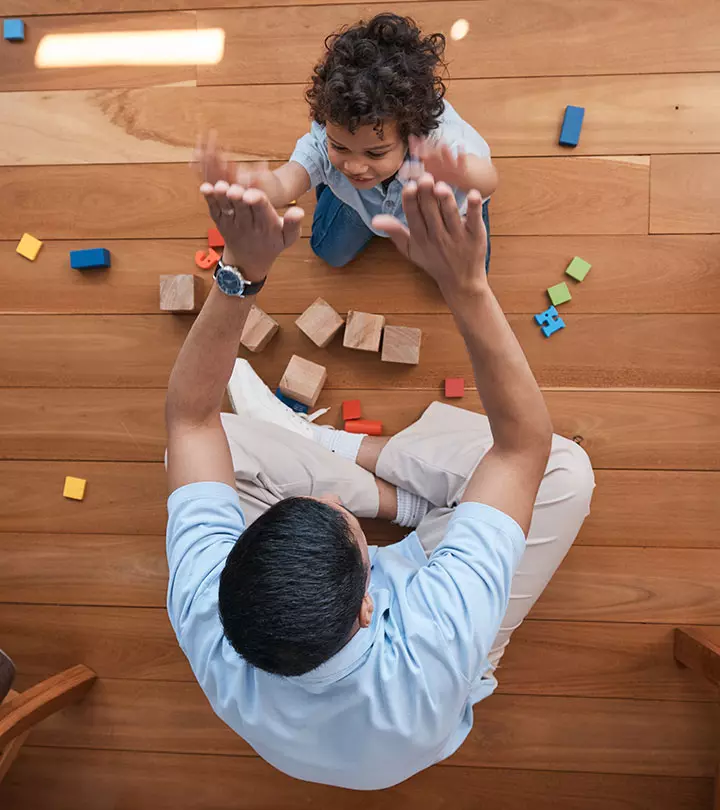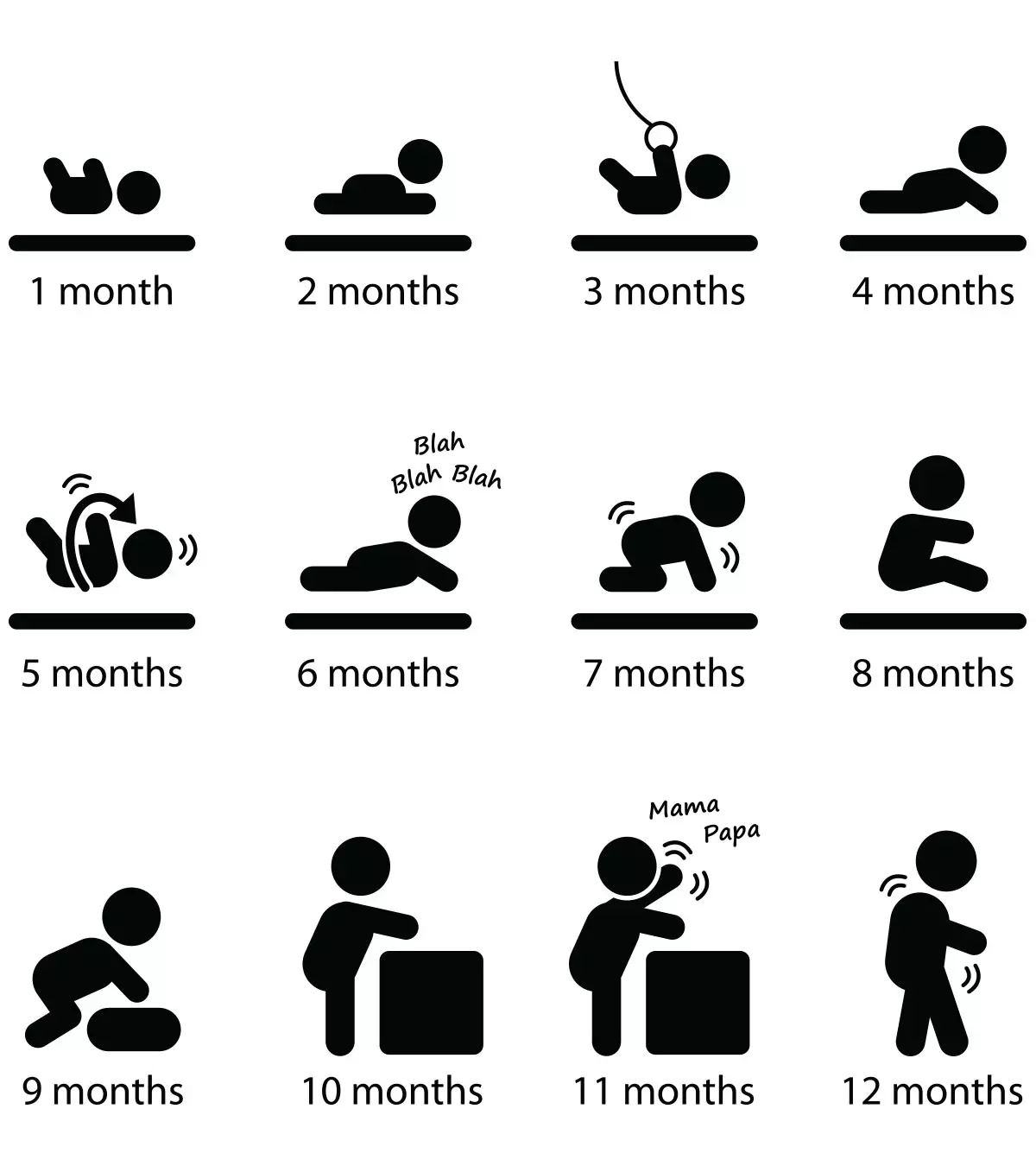
Image: Shutterstock
If you look at your 5-month-old baby’s development, you’ll see that they are now attempting to sit by lifting their hips and turning on prone-supine/supine-prone on their own.

When you place the baby in a sitting posture, you will see that now they can sit comfortably with their back straight, have a solid grasp, and babble to themselves while playing with their hands and feet. You’d be surprised how much a baby can do by the time they’re five months old.
It is essential to track your baby’s developmental milestones as it helps you understand their growth and also identify any potential developmental delays. This post discusses significant physical, cognitive, and social milestones that your baby will accomplish at five months of age, along with practical tips for supporting their growth.
Key Pointers
- Babies gain better control over their neck and head, sit without support, and try rolling over by the time they reach five months.
- Their hearing muscles improve, and they start differentiating between tastes and flavors.
- They become curious and alert as their brain capacity and vocal cord function improve.
- Introducing bright toys and stories, tummy time, and constant conversations can help improve the development of a 5-month-old baby.
5-Month-Old Milestones Chart
| Achieved Developmental Milestones | Emerging Developmental Milestones |
|---|---|
| Sits with support | |
| Rolls over from back to tummy | Rolls over from back to tummy and then to the tummy again |
| Responds to sounds, with sounds, u,n,g,k, | |
| Makes babbles | |
| Can learn to taste food after six months of age | |
| Shows curiosity towards stationary objects | Can track moving objects |
| Communicates using basic expressions | |
| Flexes legs during tummy time | May put weight on legs when held vertical |
| Recognizes familiar faces | May try to communicate with known people |
A 5-Month-Old Baby’s Developmental Milestones
We have divided these developmental milestones to three categories and will see the key formative landmarks under each category.
Cognitive Developmental Milestones

These 5-month milestones pertain to intelligence, language, thinking, and decision-making capabilities.
- More keen and discerning: Your baby is now keen on watching objects and people around him as they captivate him. As he gets a sense of reflection, he will be prone to smiling and giggling when called upon and on funny noises (1). He is more alert than ever and shows an increase in his level of curiosity.
Referring to her youngest daughter’s milestones, Amber Massey, a mother of three girls, notes, “I’ve noticed her face lights up when Jordan (her father), or I enter the room or her line of sight- and she especially loves her sisters. She is still a social little girl and wants to be in the mix of everything all the time- so when we leave she is noticeably upset, depending on what she’s doing or her mood (i).”
- Gets distracted easily: As he has a penchant for looking at new objects, distracting your baby would be easy. Walking towards him with a new toy or object in front of him, and he stops whatever he is doing to look at the fascinating new thing.
- Attracted to colorful objects: The baby still shows preference for bold and solid colors (2). This is an indicator of good eye and brain coordination along with improved retinal function.
 Quick fact
Quick fact- Shows basic language development: By the fifth month, the baby’s language development will be right on track. They would make baby babbling sounds when in a playful mood or when someone calls and tries to make an interaction. Your baby coos a lot, which now comes effortlessly to him as he gradually develops his communication skills (3). This is due to improved vocal cord function and the brain’s ability to produce sounds from it.
Physical Developmental Milestones

Physical development in infants refers to the baby’s physical growth and improvements in their fine and motor skills. Here are some physical developmental milestones you can expect in your baby at five months.
- Better hand control: Things do not slip out from his hands anymore as he has a better grip than before. Your baby will promptly use his hands to pick up objects and will even stretch them to reach objects that are beyond immediate reach. Your baby will also play with his hands while making more nimble movements with his fingers. This is also the time when he will begin grasping his feeding bottle independently. Babies join two hands together or two thumbs together and bring them near the mouth to put it in mouth. Some babies bring their toes near their mouth while holding their feet.
Amber talks about her baby Baker Bree, “She is so interested in everything, very alert and exploring. She had noticed my jewelry and plays with my necklace and earrings whenever I’m holding her.
“She will put her hand out in front of her and stare in amazement as she moves it around…it’s so cute! Her feet are her favorite toy right now. She has been grabbing them for about a month, but never really started using them to her advantage- she rocks back and forth while holding both of her feet (i).”
- Raises chest when prone: When the baby is lying prone (on his tummy), he will push his elbows down and raise his chest upwards (4). This action will later help him when he crawls.
- Better controlled neck movements: Neck muscles are stronger, and his neck is no more wobbly, which gives him a better control over the neck.
- Makes attempts to sit: Your 5 month old baby will make his first attempts to sit by raising his hips or buttocks Your baby will be able to sit if you support his back or make him sit by holding axillaiThe region where the arm connects to the shoulder (armpit). . In sitting, now back is more straighter than before.
- Can roll over in one direction: He can now roll over back to the tummy (4). Once he gets on his tummy, he will attempt to flex his legs. This is his way of strengthening his muscles before he begins crawling.
- Improved sense of taste: There are now more nerve endings on the baby’s tongue than ever before. Anything that seems interesting goes straight into the mouth. That is a way of exploration for babies as they learn about the world around them. Yes, putting things in their mouth is a baby’s way to explore the world!! It is normal and not a bad habit.
 Did you know?
Did you know?- Better hearing and muscle coordination: Say something aloud, and your little one will turn his head and look at you in attention. He may not understand his name but understands that you are talking to him. The 5-month-old even turns his head to other sounds that he finds interesting thus indicating improved hearing-muscle coordination.
A mother of four, Kaleigh Carnahan, explains the milestones of her 5-month-old baby, Aynsley, and shows how Aynsley’s father tries to talk to her at every possible moment to improve her babbling. He speaks to her in different tones while changing her diapers or getting her dressed, and she responds with equal excitement (ii).
- Sleeps in blocks of hours: The baby begins sleeping longer in blocks of hours, especially at night. This is an indicator of his improved sleep functionality.
Social And Emotional Developmental Milestones

Bonding and attachment with people around is one of the milestones your baby achieves as he grows mentally and physically.
- Displays recognition of familiar faces: The baby will have an acute recognition of individuals that he had met in the past. He smiles and looks jovial when seeing someone familiar. He also moves his hands vigorously, which is his way of greeting that person. A better long-term memory is the reason for this improved social behavior. You can see it when, baby who is seeing unknown faces, wanders around, finds mother or caretaker’s, recognises her and smiles very cordially and shows happiness.
- Shows anxiety towards strangers: Your five-month-old will show his first pangs of anxiety when left in the company of someone he does not know. If you let a stranger hold your little one then be prepared for a blaring tantrum. This anxiety towards unknown people is a primitive display of trust and confidence, or the lack of it, which constitutes the building blocks for complex relationships in the future.
- Loves playing with parents: At five months, your baby is more playful than ever before. Roll a ball towards him, and he gets all excited about it. There is a certain excitement that you notice in all his play activities especially when playing involves people he loves and trusts the most – his parents.
- Expresses emotions: Smiling will be the most frequent emotion of your baby. He now actively displays displeasure, excitement, and fatigue. He will switch between toys after playing with one showing the first signs of boredom.
Those were the various developmental milestones achieved by your baby when he is a jolly five-month-old fella. Parents can always take steps towards nurturing the physical, mental, and social development of the baby for good health and timely growth.
6 Tips To Improve The Development Of Your Five-Month-Old
Encourage and assist your five-month-old baby’s development through these easy steps and practices:
- Keep the conversations going: Speak to your little one as often as you can. You should not think whether the baby is understanding or not, you should just feed the child with your talk. Baby should not be taught but should be just given information, and he may even pick up a few simple words such as his name.

- Tummy time play is a must: Tummy time is critical for the development of your baby since it helps him exercise every muscle in his body. Babies learn muscle movement through this play time. Therefore, dedicate ample time for tummy play every day. During tummy time, place all his favorite toys around him, and encourage reaching out to them. This will help him have better dexterityiSkillful in performing tasks with fingers and hands. .
- Read aloud brightly illustrated books: Make him sit on your lap and read a book with brightly-colored illustrations, aloud. Viewing multiple shades of colors stimulates the baby’s eyes and brain.
- Show him bright colored toys: Bright, multi-colored toys fascinate your baby and play a crucial role in improving his vision palette. Stimulate his vision and visual cortexiA part of the brain that receives and processes visual information. of the brain by giving him colorful toys.
- Have them sit with support: If your baby loves sitting and puts in effort to do so, make them sit with support, preferably by making them sit on your lap. This is, like tummy time, one of the best activities for 5-month-olds, where the baby’s muscles get ample exercise and become stronger to prepare for their gradual process of standing on their own feet.
- Let him meet new people: Just because he is not comfortable around new faces does not mean you cut him off from others. Meeting new people is a great way of honing his basic social skills, while also stimulating his long-term memory.

Your five-month-old baby will certainly be on a sound development path when his milestones are further sharpened through play and activities. But there are always certain red flags in his development that you must be alert about.
When To Be Concerned?
If your baby is not developing at a normal pace, then he may show the following traits, which are signs of acute developmental backlogs:
- Does not respond to sounds: A five-month-old baby may not know you are talking to him, but he will definitely turn his head when he hears his parents speaking. He will show a general interest towards voices of primary caretakers. A lack of responsiveness or an extremely underwhelming response towards sounds could be an indicator of a hearing problem, which you must get checked.
- Poor hand control and grip: Your baby has better sensory control of his hands. But if his hands always seem floppy with disconcertingly weak grip then it could be that his muscles are not developing at a normal pace. Poor hand control and grip could be an indicator of muscular dystrophy, and you should let a pediatrician take a look at your baby.
- Has a stiff body with awkward movements: If he generally stays stiff and seems to have very poor voluntary muscle control then that is alarming. At this age, the baby prepares to have quality tummy time. A stiffness of muscles can be an indicator of a plethora of problems including serious autistic-spectrum disordersiA group of developmental disorders that affect a child’s social interaction and communication skills. . Do not jump to conclusions though and take your baby to the doctor.
 Point to consider
Point to consider- Displays no expression or affection towards parents: A baby may not smile and greet every human he meets, but he is definitely going to express joy and elation on seeing a parent. If the baby has zero expressiveness towards parents, shows no alertness, does not show concern for safety, and does not smile, then it could be a sign of a developmental backlog.
- Shows poor speech development: Babies tend to use their vocal cords a lot now. Your baby will keep you entertained with his cooing and gurgling. But if he is always quiet and does not babble, then that is definitely unsettling. It could be an early sign of speech impairment, and the sooner you get him under medical supervision, the better are his chances of subsequent recovery.
Frequently Asked Questions
1. Can a five-month-old baby eat food?
Your five-month-old baby may show signs of feeding by bringing their hands to their mouth when hungry. However, nutrition experts recommend feeding them solids or water until they are six months old (5). At five months, the mother’s breastmilk or formula is enough for them.
2. How much does a baby weigh at five months?
By five months, your baby might have doubled their birth weight (6). However, it is their doctor who can guide you best.
3. When should I start introducing solid foods to my five-month-old baby?
Your baby may be showing signs of being ready for solid foods. For example, showing hand-to-mouth coordination for feeding and losing tongue thrust (10) (11). If your baby shows other signs, such as sitting with support, mouthing toys, and showing a desire for your food, they might be ready for solid food. However, it is not recommended to give babies solids until they are six months old.
4. How can I help my five-month-old baby develop language skills?
Start having conversations with your baby from birth (12). Point to things and tell what it is. If they babble after you have said something, turn it into a conversation. Use a calm, musical tone to talk with them. Talk with them about your daily activities. Reading to them from a young age also helps babies develop strong language skills.
5. When should my five-month-old start babbling or saying their first words?
At five months, your baby will start babbling (13). They will also copy the sounds you make, such as coughing or laughing. They start making raspberries and playing with themselves by making sounds in different pitches. Babies say their first words when they are around 12 months old.
6. When should I start thinking about transitioning my five-month-old from breast milk or formula to other types of milk?
It is recommended to give your baby breast milk or formula until 12 months of age (14). If you wish to transition from breast milk at five months, you can switch to formula. When your baby reaches the age of 12 months, you can introduce cow’s milk.
7. How do vaccines at five months ensure baby safety and health?
Babies aged five to six months should receive the third dose of the DTaP vaccine (against diphtheria, tetanus, and pertussis), the third dose of Haemophilus influenzae type b (Hib) vaccine, the third dose of pneumococcal disease vaccine, the third dose of rotavirus vaccine, and the third of polio vaccine (IPV). These vaccines are essential for protecting babies against serious disease-causing microorganisms that cause infections and have enough potential to cause significant harm. At six months or above, additional vaccines include respiratory syncytial virus (RSV) vaccine, flu vaccine, and COVID-19 vaccine (15) (16).
8. What are the signs of developmental delays in a five-month-old?
Common signs include not showing interest in toys, being unable to grab or reach for them, trouble holding their head up, not rolling over, not smiling or interacting, or not sitting even with support. If you notice any of these, talk to your pediatrician for advice.
Rolling over, sitting with support, and improved hearing and expressions are the major milestones of a 5-month-old baby’s development. You may promote their development by following simple methods such as conversing with them, encouraging tummy time and sitting, and introducing different-colored toys. Also, remember that each baby’s development month-by-month varies, and you must not force your little one to do anything. Instead, let them learn and explore things to achieve their milestones while you are observant of their progress. Altogether, do not hesitate to speak to your baby’s doctor if you feel they are not meeting their developmental requirements appropriately.
Infographic: 5 Things To Observe In Your 5-Month-Old
Every parent would like to see their bundle of joy grow holistically. Track the progress of your infant’s overall development by reading this infographic about key aspects of your baby’s growth. Ensuring their requirements in these five facets can help them grow healthy.
Some thing wrong with infographic shortcode. please verify shortcode syntax
Illustration: 5-Month-Old Baby&039s Development And Milestones Chart

Image: Dall·E/MomJunction Design Team
Watch as your 5 month old baby develops new skills and personality traits! See them smile, laugh, and explore the world around them.
Personal Experience: Sources
MomJunction articles include first-hand experiences to provide you with better insights through real-life narratives. Here are the sources of personal accounts referenced in this article.
i. Baker bree | 5 months.
https://themasseyspot.blogspot.com/2015/12/baker-bree-5-months.html
ii. How To Play With Your 5 Month Old | Developmental Milestones | What You Need To Know.
https://www.youtube.com/watch?v=g2T7kqLCwpY
References
- First Year Infant Development.
https://americanpregnancy.org/healthy-pregnancy/first-year-of-life/first-year-infant-development/ - Infant Vision: Birth to 24 Months of Age.
https://www.aoa.org/healthy-eyes/eye-health-for-life/infant-vision?sso=y - Age-Appropriate Speech and Hearing Milestones.
https://www.hopkinsmedicine.org/health/conditions-and-diseases/hearing-loss/ageappropriate-speech-and-hearing-milestones - Infant – newborn development.
https://medlineplus.gov/ency/article/002004.htm - Age Appropriate Vision Milestones
https://www.stanfordchildrens.org/en/topic/default?id=age-appropriate-vision-milestones-90-P02305 - Eye-Catching Odors: Olfaction Elicits Sustained Gazing to Faces and Eyes in 4-Month-Old Infants
https://www.ncbi.nlm.nih.gov/pmc/articles/PMC3756010/ - Spinal Muscular Atrophy
https://kidshealth.org/en/parents/sma.html#:~:text=Type%20I%20begins%20to%20affect,7%20and%2018%20months%20old - Feeding your baby: When to start with solid foods.
https://www.unicef.org/parenting/food-nutrition/feeding-your-baby-when-to-start-solid-foods - Your Baby’s Growth: 5 Months.
https://kidshealth.org/en/parents/growth-5mos.html - Infant and toddler health
https://www.mayoclinic.org/healthy-lifestyle/infant-and-toddler-health/in-depth/healthy-baby/art-20046200 - When, What, and How to Introduce Solid Foods
https://www.cdc.gov/infant-toddler-nutrition/foods-and-drinks/when-what-and-how-to-introduce-solid-foods.html?CDC_AAref_Val=https://www.cdc.gov/nutrition/infantandtoddlernutrition/foods-and-drinks/when-to-introduce-solid-foods.html - Let’s Talk About It: 5 Ways to Build Babies’ Language and Communication Skills from Birth
https://www.zerotothree.org/resource/lets-talk-about-it-5-ways-to-build-babies-language-and-communication-skills-from-birth/ - Language development: 3-12 months
https://raisingchildren.net.au/babies/development/language-development/language-3-12-months - Weaning From Breastfeeding
https://www.cdc.gov/infant-toddler-nutrition/breastfeeding/weaning.html?CDC_AAref_Val=https://www.cdc.gov/nutrition/infantandtoddlernutrition/breastfeeding/weaning.html - Vaccines by Age
https://www.cdc.gov/vaccines/by-age/?CDC_AAref_Val=https://www.cdc.gov/vaccines/parents/by-age/months-6.html - RSV Immunization Guidance for Infants and Young Children
https://www.cdc.gov/rsv/hcp/vaccine-clinical-guidance/infants-young-children.html
Community Experiences
Join the conversation and become a part of our nurturing community! Share your stories, experiences, and insights to connect with fellow parents.
Read full bio of Dr. Hina Patel Desai
Read full bio of Rohit Garoo
Read full bio of Dr. Ritika Shah
Read full bio of Vibha Navarathna
















